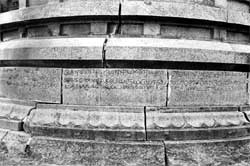The State s non bureaucratic role of encouraging the people
 Pre-colonial roots
Pre-colonial roots
When the British disembarked on the Indian shores, they saw a land extremely rich, highly urbanised and intensely literate, with a flourishing tradition of arts, crafts and literature. The wealth of the land came from its internal resource mobilisation. The surplus generated in the villages not only supported the villages themselves, but also the cities and towns of the country. Over the centuries, Indians had learnt to use their land-water-vegetation resources in an intelligent and sustainable manner. The resource base around each village had been transformed into a complex agro-ecosystem of croplands, grazing lands (grasslands), and forest and tree lands, thus constituting an interactive multi-componential biological system that responded not only to the region's sharp seasonal rhythms, but also reduced risk by keeping the social and economic impact of rainfall variations down to a minimum. Due to the seasonal nature of rains, the people learnt to store the rainwater or the streamwater that flowed past during the monsoon season, in their own villages. When the British came, there were already thousands of water storage tanks in use across the country.
The Indian rulers preceding the British did not boast of irrigation bureaucracies or public works departments to create these structures. Referring to Rajasthan's Thar desert, traditional knowledge expert Komal Kothari says, "While collecting information from some 600 villages, I found that the state, the jagirdar (landowner) or anybody who had anything to do with revenue collection did not create any water body for the people. All water bodies constructed by the erstwhile kings, jagirdars, chiefs and chieftains were reserved for their personal use. The people largely had to fend for themselves.' Though the role of the state varied from one region to another, it was nonetheless true that the rulers rarely built irrigation structures themselves. The massive Pichola lake in the city of Udaipur, for instance, was built by nomadic gypsies. However, the rulers did play an important role in encouraging people to build water harvesting structures.
The Vijayanagar empire
The famous Vijayanagar kings of south India (1336-1564 ad), for instance, placed great importance on developing irrigation facilities for agricultural improvement. Emperor Krishnadeva Raya (1509-1530), the greatest of the Vijayanagar rulers, once pointed out that the extent of a state is the root cause of its prosperity. Conversely, if the state was small, its prosperity will increase only when tanks and irrigation canals were constructed and favour was shown to poor cultivators in matters of taxation and services. The Vijayanagar kings, therefore, constructed irrigation tanks and canals themselves, though more rarely. But, more importantly, they encouraged private initiative in irrigation development in different ways.
In those days, land tax, which was collected in kind in the form of one-sixth of the produce, was an important source of revenue for Indian rulers. Thus, the rulers' fortunes depended on agriculture. The state, therefore, had a vested interest in encouraging private initiative to develop irrigation systems. The Vijayanagar kings would make dasavanda or kattu kodage grants to individuals or institutions which undertook such works. The enterprising person would be granted a piece of tax-free land watered by the tank, canal or well which he/she excavated. The extent of the grant varied with the importance of the work. Thus, when one Harinideva Vodeyar constructed a tank in Mysore district, he was given a grant by emperor Deva Raya ii (1423-1446); Vodeyar received a second grant when he enlarged the tank.
Dasavanda grants were made not just by the kings. A record of 1497 in the present Chittoor district registers a kattu kodage grant of land at Gundalahalli, made by the sthanika (manager) of a temple to one Narasimhadeva for digging a tank in the village belonging to the Kadiri Lakshminarsimha temple and for bringing the surrounding lands under cultivation.
Great religious merit was also attached to the maintenance and repair of irrigation works by the Vijayanagar kings. An inscription dating to 1413 states: "A ruined family, a breached tank or pond, a fallen kingdom, whomsoever restores, or repairs a damaged temple, acquires merit four-fold of that which accrued from them at first.'
Early British observers were full of praise for the Vijayanagar irrigation works they saw. C S Crole, author of The Manual of Chengleput District (1879), said: "Almost every catchment basin, however small, still bears traces of having been bunded across and in many instances this was done in order to secure a crop of paddy on a few acres of stony ungenerous soil, to which all the fostering care of the British administration has failed to induce cultivation to return. Large and more expensive projects were not neglected. Even some of them bear witness to the enlightenment of those Hindu kings, while the absence of scientific instruments in those remote times compels the astonishment of the beholder.'
Colonel Thomas Munro (the governor of Madras in 1820), noting the irrigation system in the area around Vijayanagar, said: "To attempt the construction of new tanks is perhaps a more hopeless experiment than the repair of those which have been filled up (through siltation), for there is scarcely any place where a tank can be made to advantage that has not been applied to this purpose by the inhabitants.'
The Gond kingdom
The tribal Gond ings, who were great empire builders
